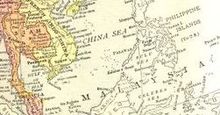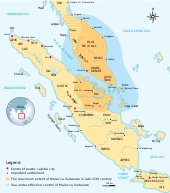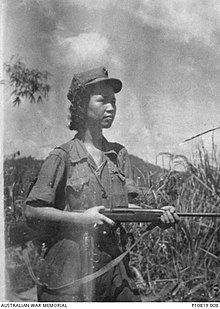Malaysia (/məˈleɪziə, –ʒə/ (![]() listen) mə-LAY-zee-ə, -zhə; Malay: [malɛjsia]) is a country in Southeast Asia. The federal constitutional monarchy consists of thirteen states and three federal territories, separated by the South China Sea into two regions: Peninsular Malaysia and Borneo‘s East Malaysia. Peninsular Malaysia shares a land and maritime border with Thailand and maritime borders with Singapore, Vietnam, and Indonesia. East Malaysia shares land and maritime borders with Brunei and Indonesia, as well as a maritime border with the Philippines and Vietnam. Kuala Lumpur is the national capital, the country’s largest city, and the seat of the legislative branch of the federal government. Putrajaya is the country’s administrative centre, which represents the seat of both the executive branch (the Cabinet and federal ministries and agencies) and the judicial branch of the federal government. With a population of over 33 million, Malaysia is the world’s 43rd-most populous country. The southernmost point of continental Eurasia is Tanjung Piai. Located in the tropics, Malaysia is one of 17 megadiverse countries and home to numerous endemic species.
listen) mə-LAY-zee-ə, -zhə; Malay: [malɛjsia]) is a country in Southeast Asia. The federal constitutional monarchy consists of thirteen states and three federal territories, separated by the South China Sea into two regions: Peninsular Malaysia and Borneo‘s East Malaysia. Peninsular Malaysia shares a land and maritime border with Thailand and maritime borders with Singapore, Vietnam, and Indonesia. East Malaysia shares land and maritime borders with Brunei and Indonesia, as well as a maritime border with the Philippines and Vietnam. Kuala Lumpur is the national capital, the country’s largest city, and the seat of the legislative branch of the federal government. Putrajaya is the country’s administrative centre, which represents the seat of both the executive branch (the Cabinet and federal ministries and agencies) and the judicial branch of the federal government. With a population of over 33 million, Malaysia is the world’s 43rd-most populous country. The southernmost point of continental Eurasia is Tanjung Piai. Located in the tropics, Malaysia is one of 17 megadiverse countries and home to numerous endemic species.
Malaysia has its origins in the Malay kingdoms, which, from the 18th century on, became subject to the British Empire, along with the British Straits Settlements protectorate. During World War Two, British Malaya, along with other nearby British and American colonies, was occupied by the Empire of Japan.[14] Following three years of occupation, Peninsular Malaysia was unified as the Malayan Union in 1946 and then restructured as the Federation of Malaya in 1948. Malaysia achieved independence on 31 August 1957. On 16 September 1963, independent Malaya united with the then British crown colonies of North Borneo, Sarawak, and Singapore to become Malaysia. In August 1965, Singapore was expelled from the federation and became a separate, independent country.[15]
Malaysia is multiethnic and multicultural, which has a significant effect on its politics. About half the population is ethnically Malay, with minorities of Chinese, Indians, and indigenous peoples. The official language is Malaysian Malay, a standard form of the Malay language. English remains an active second language. While recognising Islam as the official religion, the constitution grants freedom of religion to non-Muslims. The government is modelled on the Westminster parliamentary system, and the legal system is based on common law. The head of state is an elected monarch, chosen from among the nine state sultans every five years. The head of government is the prime minister.
After independence, the gross domestic product (GDP) grew at an average rate of 6.5% per year for almost 50 years. The country’s economy has traditionally been fuelled by its natural resources but is expanding into commerce, medical tourism, and tourism. Malaysia has a newly industrialised market economy, ranked third-largest in Southeast Asia and 36th-largest in the world.[16] Malaysia is a founding member of the Asia-Pacific Economic Cooperation (APEC), the Association of Southeast Asian Nations (ASEAN), the Commonwealth, the East Asia Summit (EAS), the Non-Aligned Movement (NAM), and the Organisation of Islamic Cooperation (OIC).
Etymology

The name Malaysia is a combination of the word Malays and the Latin-Greek suffix -ia/-ία[17] which can be translated as ‘land of the Malays’.[18] The origin of the word Melayu is subject to various theories. It may derive from the Sanskrit Himalaya, referring to areas high in the mountains, or Malaiyur-pura, meaning ‘mountain town’.[19] Another similar theory claims its origin lies in the Tamil words malai and ur meaning ‘mountain’ and ‘city, land’, respectively.[20][21][22] Another suggestion is that it derives from the Pamalayu campaign. A final suggestion is that it comes from a Javanese word meaning ‘to run’, from which a river, the Sungai Melayu (‘Melayu river’), was named due to its strong current.[19] Similar-sounding variants have also appeared in accounts older than the 11th century, as toponyms for areas in Sumatra or referring to a larger region around the Strait of Malacca.[23] The Sanskrit text Vayu Purana, thought to have been in existence since the first millennium CE, mentioned a land named ‘Malayadvipa’ which was identified by certain scholars as the modern Malay peninsula.[24][25][26][27][28] Other notable accounts are by the 2nd-century Ptolemy’s Geographia that used the name Malayu Kulon for the west coast of Golden Chersonese, and the 7th-century Yijing‘s account of Malayu.[23]
At some point, the Melayu Kingdom took its name from the Sungai Melayu.[19][29] Melayu then became associated with Srivijaya,[23] and remained associated with various parts of Sumatra, especially Palembang, where the founder of the Malacca Sultanate is thought to have come from.[30] It is only thought to have developed into an ethnonym as Malacca became a regional power in the 15th century. Islamisation established an ethnoreligious identity in Malacca, with the term Melayu beginning to appear as interchangeable with Melakans. It may have specifically referred to local Malays speakers thought loyal to the Malaccan Sultan. The initial Portuguese use of Malayos reflected this, referring only to the ruling people of Malacca. The prominence of traders from Malacca led Melayu to be associated with Muslim traders, and from there became associated with the wider cultural and linguistic group.[23] Malacca and later Johor claimed they were the centre of Malay culture, a position supported by the British which led to the term Malay becoming more usually linked to the Malay peninsula rather than Sumatra.[30]
Before the onset of European colonisation, the Malay Peninsula was known natively as Tanah Melayu (‘Malay Land’).[31] Under a racial classification created by a German scholar Johann Friedrich Blumenbach, the natives of maritime Southeast Asia were grouped into a single category, the Malay race.[32][33] Following the expedition of French navigator Jules Dumont d’Urville to Oceania in 1826, he later proposed the terms of Malaysia, Micronesia and Melanesia to the Société de Géographie in 1831, distinguishing these Pacific cultures and island groups from the existing term Polynesia. Dumont d’Urville described Malaysia as “an area commonly known as the East Indies”.[34] In 1850, the English ethnologist George Samuel Windsor Earl, writing in the Journal of the Indian Archipelago and Eastern Asia, proposed naming the islands of Southeast Asia as “Melayunesia” or “Indunesia”, favouring the former.[35] The name Malaysia gained some use to label what is now the Malay Archipelago.[36] In modern terminology, Malay remains the name of an ethnoreligious group of Austronesian people predominantly inhabiting the Malay Peninsula and portions of the adjacent islands of Southeast Asia, including the east coast of Sumatra, the coast of Borneo, and smaller islands that lie between these areas.[37]
The state that gained independence from the United Kingdom in 1957 took the name the Federation of Malaya, chosen in preference to other potential names such as Langkasuka, after the historic kingdom located at the upper section of the Malay Peninsula in the first millennium CE.[38][39] The name Malaysia was adopted in 1963 when the existing states of the Federation of Malaya, plus Singapore, North Borneo and Sarawak formed a new federation.[40][d] One theory posits the name was chosen so that si represented the inclusion of Singapore, North Borneo, and Sarawak to Malaya in 1963.[40] Politicians in the Philippines contemplated renaming their state Malaysia before the modern country took the name.[42]
Malaysia | |
|---|---|
| Motto: Bersekutu Bertambah Mutu[1] برسکوتو برتمبه موتو (Jawi) “Unity is Strength“ | |
| Anthem: Negaraku “My Country” 0:59 | |
| Capital and largest city | Kuala Lumpur[fn 1] 3°8′N 101°41′E 3°8′N 101°41′E |
| Administrative center | Putrajaya[fn 2] 2°56′N 101°42′E 2°56′N 101°42′E |
| Official languages | Malay[a][b][c] |
| Recognised language | English[c] |
| Ethnic groups |
|
| Religion (2020)[5] |
|
| Demonym(s) | Malaysian |
| Government | Federal parliamentary constitutional elective monarchy |
• Monarch | Abdullah |
| Anwar Ibrahim | |
| Legislature | Parliament |
| Dewan Negara (Senate) | |
| Dewan Rakyat (House of Representatives) | |
| Independence from the United Kingdom | |
| 31 August 1957[6] | |
| 22 July 1963 | |
| 31 August 1963[7] | |
| 16 September 1963 | |
| Area | |
• Total | 330,803[8] km2 (127,724 sq mi) (67th) |
• Water (%) | 0.3 |
| Population | |
• 2023 estimate | 33,200,000[9] (43rd) |
• 2020 census | 32,447,385[10] |
• Density | 101/km2 (261.6/sq mi) (116th) |
| GDP (PPP) | 2023 estimate |
• Total | |
• Per capita | |
| GDP (nominal) | 2023 estimate |
• Total | |
• Per capita | |
| Gini (2018) | medium |
| HDI (2021) | very high · 62nd |
| Currency | Ringgit (RM) (MYR) |
| Time zone | UTC+8 (MST) |
| Date format | dd-mm-yyyy |
| Driving side | left |
| Calling code | +60 |
| ISO 3166 code | MY |
| Internet TLD | .my |
History

Evidence of modern human habitation in Malaysia dates back 40,000 years.[43] In the Malay Peninsula, the first inhabitants are thought to be Negritos.[44] Traders and settlers from India and China arrived as early as the first century AD, establishing trading ports and coastal towns in the second and third centuries. Their presence resulted in strong Indian and Chinese influences on the local cultures, and the people of the Malay Peninsula adopted the religions of Hinduism and Buddhism. Sanskrit inscriptions appear as early as the fourth or fifth century.[45] The Kingdom of Langkasuka arose around the second century in the northern area of the Malay Peninsula, lasting until about the 15th century.[38] Between the 7th and 13th centuries, much of the southern Malay Peninsula was part of the maritime Srivijayan empire. By the 13th and the 14th century, the Majapahit empire had successfully wrested control over most of the peninsula and the Malay Archipelago from Srivijaya.[46] In the early 15th century, Parameswara, a runaway king of the former Kingdom of Singapura linked to the old Srivijayan court, founded the Malacca Sultanate.[47] The spread of Islam increased following Parameswara’s conversion to that religion. Malacca was an important commercial centre during this time, attracting trade from around the region.[48]

In 1511, Malacca was conquered by Portugal,[48] after which it was taken by the Dutch in 1641. In 1786, the British Empire established a presence in Malaya, when the Sultan of Kedah leased Penang Island to the British East India Company. The British obtained the town of Singapore in 1819,[49] and in 1824 took control of Malacca following the Anglo-Dutch Treaty. By 1826, the British directly controlled Penang, Malacca, Singapore, and the island of Labuan, which they established as the crown colony of the Straits Settlements. By the 20th century, the states of Pahang, Selangor, Perak, and Negeri Sembilan, known together as the Federated Malay States, had British residents appointed to advise the Malay rulers, to whom the rulers were bound to defer by treaty.[50] The remaining five states on the peninsula, known as the Unfederated Malay States, while not directly under British rule, also accepted British advisers around the turn of the 20th century. Development on the peninsula and Borneo were generally separate until the 19th century. Under British rule the immigration of Chinese and Indians to serve as labourers was encouraged.[51] The area that is now Sabah came under British control as North Borneo when both the Sultan of Brunei and the Sultan of Sulu transferred their respective territorial rights of ownership, between 1877 and 1878.[52] In 1842, Sarawak was ceded by the Sultan of Brunei to James Brooke, whose successors ruled as the White Rajahs over an independent kingdom until 1946, when it became a crown colony.[53]
In the Second World War, the Japanese Army invaded and occupied Malaya, North Borneo, Sarawak, and Singapore for over three years. During this time, ethnic tensions were raised and nationalism grew.[54] Popular support for independence increased after Malaya was reconquered by Allied forces.[55] Post-war British plans to unite the administration of Malaya under a single crown colony called the “Malayan Union” met with strong opposition from the Malays, who opposed the weakening of the Malay rulers and the granting of citizenship to the ethnic Chinese. The Malayan Union, established in 1946, and consisting of all the British possessions in the Malay Peninsula with the exception of Singapore, was quickly dissolved and replaced on 1 February 1948 by the Federation of Malaya, which restored the autonomy of the rulers of the Malay states under British protection.[56]

During this time, the mostly ethnically Chinese rebels under the leadership of the Malayan Communist Party launched guerrilla operations designed to force the British out of Malaya. The Malayan Emergency (1948–1960) involved a long anti-insurgency campaign by Commonwealth troops in Malaya.[57] On 31 August 1957, Malaya became an independent member of the Commonwealth of Nations.[58] Subsequently, a comprehensive plan was devised to unite Malaya with the crown colonies of North Borneo (known as Sabah upon joining), Sarawak, and Singapore. The envisioned federation was originally intended to take place on 31 August 1963, to coincide with the commemoration of Malayan independence. However, due to the necessity of conducting a survey on the level of support for the federation in Sabah and Sarawak by the United Nations, as requested by opponents of the federation such as Indonesia‘s Sukarno and the Sarawak United Peoples’ Party, the date of the federation was postponed until 16 September 1963. This delay allowed sufficient time for the completion of the aforementioned survey.[59][60]
The federation brought heightened tensions including a conflict with Indonesia as well as continual conflicts against the Communists in Borneo and the Malayan Peninsula, which escalated to the Sarawak Communist Insurgency and Second Malayan Emergency together with several other issues such as the cross-border attacks into North Borneo by Moro pirates from the southern islands of the Philippines, Singapore being expelled from the Federation in 1965,[61][62] and racial strife. This strife culminated in the 13 May race riots in 1969.[63] After the riots, the controversial New Economic Policy was launched by Prime Minister Tun Abdul Razak, trying to increase the share of the economy held by the bumiputera.[64] Under Prime Minister Mahathir Mohamad there was a period of rapid economic growth and urbanization beginning in the 1980s. The economy shifted from being agriculturally based to one based on manufacturing and industry. Numerous mega-projects were completed, such as the Petronas Towers, the North–South Expressway, the Multimedia Super Corridor, and the new federal administrative capital of Putrajaya.[40]
In the late 1990s, the Asian financial crisis impacted the country, nearly causing their currency, stock, and property markets to crash; however, they later recovered.[65] The 1MDB scandal was a major global corruption scandal that implicated then-Prime Minister Najib Razak in 2015.[66] The scandal contributed to the first change in the ruling political party since independence in the 2018 general election.[67] In the 2020s, the country was gripped by a political crisis that coincided with health and economic crises caused by the COVID-19 pandemic.[68] This was then followed by an earlier general election in November 2022, which resulted in the first hung parliament in the nation’s history.[69] On 24 November 2022, Anwar Ibrahim was sworn in as the 10th Prime Minister of Malaysia, leading a grand coalition government.



